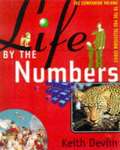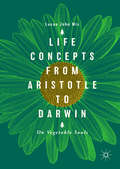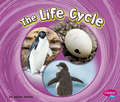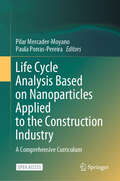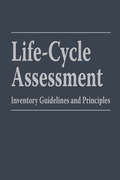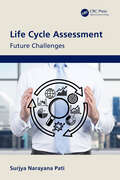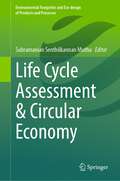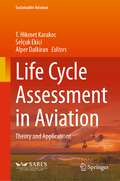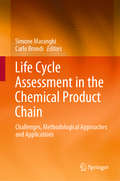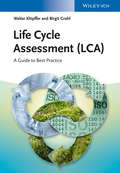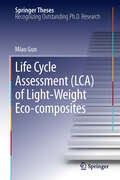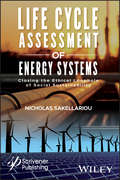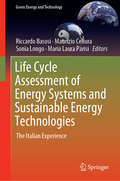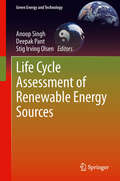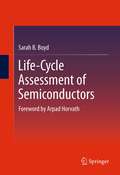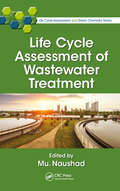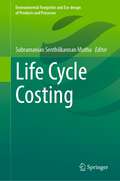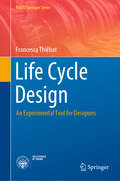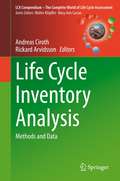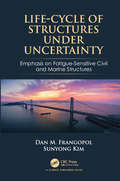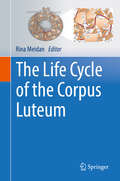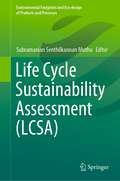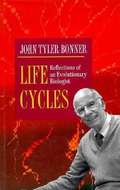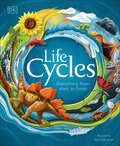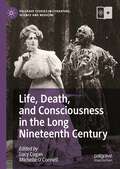- Table View
- List View
Life by the Numbers
by Keith J. DevlinThis companion to the PBS television series offers illustrated proof that mathematics is a vital and creative way of thinking and seeing, without using a single mathematical equation. Explores the range of ways in which scientists, artists, athletes, medical researchers, and others are using mathematics, and profiles present-day male and female pioneers in mathematics and science. Discussions ranging from deep-sea volcanoes to movie special effects and wearable computers are illustrated with color photos and drawings. For general readers high school and up. [This text is listed as an example that meets Common Core Standards in English language arts in grades 9-10 at http://www.corestandards.org.]
Life Concepts from Aristotle to Darwin: On Vegetable Souls
by Lucas John MixThis book traces the history of life-concepts, with a focus on the vegetable souls of Aristotle, investigating how they were interpreted and eventually replaced by evolutionary biology. Philosophers have long struggled with the relationship between physics, physiology, and psychology, asking questions of organization, purpose, and agency. For two millennia, the vegetable soul, nutrition, and reproduction were commonly used to understand basic life and connect it to “higher” animal and vegetable life. Cartesian dualism and mechanism destroyed this bridge and left biology without an organizing principle until Darwin. Modern biology parallels Aristotelian vegetable life-concepts, but remains incompatible with the animal, rational, subjective, and spiritual life-concepts that developed through the centuries. Recent discoveries call for a second look at Aristotle’s ideas – though not their medieval descendants. Life remains an active, chemical process whose cause, identity, and purpose is self-perpetuation.
The Life Cycle (Cycles of Nature)
by Jaclyn JaycoxFrom butterflies to sunflowers, each living thing follows a life cycle. Uncover the facts of both animal and plant life cycles, and learn how people's actions can impact them.
Life Cycle Analysis Based on Nanoparticles Applied to the Construction Industry: A Comprehensive Curriculum
by Pilar Mercader-Moyano Paula Porras-PereiraThis open access book describes in the recent years, there has been a notable upsurge in the use of nanomaterials, particularly within the construction and building sectors. The incorporation of nanoparticles introduces noteworthy changes in the physico-mechanical and physical–chemical characteristics of construction materials. Despite the acknowledged advantages of employing nanomaterials, uncertainties persist regarding their widespread adoption in development and applications, especially concerning potential environmental and human health implications. A crucial aspect in thoroughly assessing the environmental impacts of nanoproducts is the imperative quantification of effects on ecosystems and human health throughout the entire life cycle of these products. The indispensable utilization of a comprehensive tool, such as Life Cycle Assessment, becomes paramount in gaining a nuanced understanding of potential environmental and health challenges, thereby ensuring the environmental sustainability of nanomaterials. This academic publication endeavours to provide nanoproduct manufacturers, construction industry professionals, and waste managers with the necessary knowledge to comprehend the environmental and health impacts associated with the manufacturing, application, and disposal processes of nanoproducts used in the construction industry. This contribution aims to enhance their personal and professional development, consequently bolstering their employability at the European level. A thorough comprehension of potential releases throughout the entire life cycle of nanoproducts and their potential effects is imperative for ensuring the safe and sustainable utilization of these innovative materials. The application of life cycle thinking emerges as a pivotal component in appropriately evaluating the potential impacts associated with nanomaterial releases.
Life-Cycle Assessment: Inventory Guidelines and Principles
by Battelle Memorial Institute Mary Ann CurranLife-Cycle Assessment presents a brief overview of the development of the life-cycle assessment process and develops guidelines and principles for implementation of a product life-cycle inventory analysis. The book describes inventory analysis, impact analysis, and improvement analysis-the three components of a product life-cycle assessment. It discusses the major stages in a life cycle, including raw materials acquisition, materials manufacture, final product fabrication, filling/packaging/distribution, and consumer use and disposal.
Life Cycle Assessment: Future Challenges
by Surjya Narayana PatiThis book offers an itemized analysis of Life Cycle Assessment (LCA), for use in any processes, products, services, industries, organizations and so forth. Various challenges faced during applications of LCA, and its extension are discussed including their benefits. Further, the book provides practical examples of LCA in different core sectors, such as cement and construction. Each chapter functions as a stand-alone unit within the book and defines its individual role within the overall concept of LCA. Features: Covers Life Cycle Assessment (LCA) and future challenges including its practical applications as climate change tool. Connects life cycle management and LCA/environmental management. Explains benefits of LCA studies for both internal and external purpose in terms of various impact parameters. Identifies different raw materials or alternate energy mediums for changing inputs to reduce environmental impacts. Discusses extension of LCA concept like LCC, LCSA, SCLA, and OLCA. This book is aimed at professionals in all engineering areas and environmental studies.
Life Cycle Assessment & Circular Economy (Environmental Footprints and Eco-design of Products and Processes)
by Subramanian Senthilkannan MuthuThis contributed volume offers several cases in life cycle assessment (LCA) and implementation of circular economy principles across different industries. LCA is a tool which is utilized to measure the environmental footprints of various products from inception through disposal. Circular economy, a related concept, presents a meaningful alternative to a traditional linear economy as it seeks possible ways to reduce waste, recover resources at the end of a product’s life, and channel them back into production, thus significantly reducing environmental impacts. LCA and CE complement each other, as the former can be used to meaningfully assess possibilities for the latter. The combination of the principles of CE and LCA enable product developers to quantify the environmental performance of various products, processes and supply chain configurations in order to make progress toward sustainability.
Life Cycle Assessment in Aviation: Theory and Applications (Sustainable Aviation)
by T. Hikmet Karakoc Selçuk Ekici Alper DalkiranLife Cycle Assessment in Aviation: Theory and Applications provides readers with a comprehensive analysis that examines various elements within the aviation sector, including aircraft operations, maintenance and repair activities, aircraft gas turbine engine processes, airport auxiliary vehicles, airport operations, airport construction, airport access traffic, and airport wastes. The book’s content has been meticulously crafted to address the specific needs and interests of a diverse audience encompassing researchers, engineering students, and civil aviation organization officials. Readers will find valuable insights and up-to-date information about the latest developments in the aviation field, serving as a valuable resource for their investigations and studies.
Life Cycle Assessment in the Chemical Product Chain: Challenges, Methodological Approaches and Applications
by Simone Maranghi Carlo BrondiThis book outlines the methodologies, approaches and tools for modelling chemicals in a Life Cycle Assessment (LCA) perspective, and also covers the main advantages and drawbacks of applying LCA to chemical processes. In the first part of this book, authors pay close attention to the limitations of modelling the environmental and social impacts of chemical processes, providing valuable insights to the problems of the Life Cycle Inventory (LCI) analysis for chemical processes. In the second part of this book, readers will learn about the LCA application to chemical processes in the laboratory and industrial scale. In each chapter of this book, readers will also find specific case studies on the modelling and application of LCA in the chemical industry.
Life Cycle Assessment (LCA): A Guide to Best Practice
by Walter Klöpffer Birgit GrahlThis first hands-on guide to ISO-compliant Life Cycle Assessment (LCA) makes this powerful tool immediately accessible to both professionals and students. Following a general introduction on the philosophy and purpose of LCA, the reader is taken through all the stages of a complete LCA analysis, with each step exemplified by real-life data from a major LCA project on beverage packaging. Measures as carbon and water footprint, based on the most recent international standards and definitions, are addressed. Written by two pioneers of LCA, this practical volume is targeted at first-time LCA users but equally makes a much-valued reference for more experienced practitioners. From the content: * Goal and Scope Definition * Life Cycle Inventory Analysis * Life Cycle Impact Assessment * Interpretation, Reporting and Critical Review * From LCA to Sustainability Assessment and more.
Life Cycle Assessment (LCA) of Light-Weight Eco-composites
by Miao GuoMiao Guo's PhD thesis provides scientific insights into the environmental issues related to biocomposites based on starch-polyvinyl alcohol (PVOH) blends. The author contributes significantly to the methodological issues underlying the Life Cycle Assessment (LCA) modelling approach. As well as presenting complete LCA inventories using primary data from a variety of sources, Guo develops a new modelling approach incorporating the process-oriented biogeochemistry model Denitrification-Decomposition (DNDC) into site-specific LCA studies to simulate carbon and nitrogen dynamics in the wheat agro-ecosystem. This thesis addresses important LCA data quality issues by using comprehensive sensitivity and uncertainty analyses and has resulted in a large number of publications in internationally renowned journals.
Life Cycle Assessment of Energy Systems: Closing the Ethical Loophole of Social Sustainability
by Nicholas SakellariouEnergy and sustainability are two of the most important and often most misunderstood subjects in our world today. As these two subjects have grown in importance over the last few decades, interest in the Life Cycle Assessment (LCA) model has grown as well, as a potentially crucial tool in understanding and striving towards sustainability in energy systems. Not just wind and solar systems, but all energy systems, need to be understood through this model. Wind and solar power have the potential to decentralize the U.S. energy system by offering local communities electricity and economic support, depending on the scale and design of projects. Nevertheless, every energy technology potentially faces environmental costs, lay and expert opposition, and risks to public health. Engineers play a central role as designers, builders, and operators in energy systems. As they extend their expertise into electrical, mechanical and chemical fields, from fossil fuel-based systems to renewable energy systems, “sustainability” is steadily becoming one of the key criteria engineers apply in their work. This groundbreaking new study argues that engineering cultures foster sustainability by adopting assumptions and problem-solving practices as part of their identities when designing and building engineering projects. This work examines the politics of creating, utilizing, and modifying Life Cycle Assessment (LCA) in the construction of renewable energy systems. The only volume of its kind ever written, it is a must-have for any engineer, scientist, manager, or other professional working in or interested in Life Cycle Assessment and its relation to energy systems and impact on environmental and economic sustainability.
Life Cycle Assessment of Energy Systems and Sustainable Energy Technologies: The Italian Experience (Green Energy and Technology)
by Riccardo Basosi Maurizio Cellura Sonia Longo Maria Laura ParisiThis book deals with the application of life cycle assessment (LCA) methodology to sustainable energy systems and technologies. It reviews the state-of-the-art of the Italian experiences on the LCA applied to energy, and the most recent results from research in this field, with a particular focus on renewables, bio-energy and sustainable solutions. The contributors describe in detail the applications of LCA to various energy system topics, including: • electricity production, smart energy grids and energy storage systems;• renewable energy production from biomass;• production of biodiesel from microalgae;• environmental impacts of biomass power plants; and• geothermal energy production. These topics are supported by critical reviews and case studies, with discussions of Italian examples, demonstrating LCA’s application to various energy systems. A particular focus is placed on bio-energies and bio-energy systems, demonstrating how LCA can be used for optimal bio-energy production. This book offers an opportunity for researchers and advanced practitioners in the field of LCA to learn more about the application of LCA methodology to energy systems and technologies. It will also be of interest to students, as it enables them to understand the environmental impacts of energy systems and sustainable energy technologies, through the analysis of their life cycles.
Life Cycle Assessment of Renewable Energy Sources
by Deepak Pant Stig Irving Olsen Anoop SinghGovernments are setting challenging targets to increase the production of energy and transport fuel from sustainable sources. The emphasis is increasingly on renewable sources including wind, solar, geothermal, biomass based biofuel, photovoltaics or energy recovery from waste. What are the environmental consequences of adopting these other sources? How do these various sources compare to each other? Life Cycle Assessment of Renewable Energy Sources tries to answer these questions based on the universally adopted method of Life Cycle Assessment (LCA). This book introduces the concept and importance of LCA in the framework of renewable energy sources and discusses the key issues in conducting their LCA. This is followed by an in-depth discussion of LCA for some of the most common bioenergy sources such as agricultural production systems for biogas and bioethanol, biogas from grass, biodiesel from palm oil, biodiesel from used cooking oil and animal fat, Jatropha biodiesel, lignocellulosic bioethanol, ethanol from cassava and sugarcane molasses, residential photovoltaic systems, wind energy, microalgal biodiesel, biohydrogen and biomethane. Through real examples, the versatility of LCA is well emphasized. Written by experts all over the globe, the book is a cornucopia of information on LCA of bioenergy systems and provides a platform for stimulation of new ideas and thoughts. The book is targeted at practitioners of LCA and will become a useful tool for researchers working on different aspects of bioenergy.
Life-Cycle Assessment of Semiconductors
by Sarah B. BoydLife-Cycle Assessment of Semiconductors presents the first and thus far only available transparent and complete life cycle assessment of semiconductor devices. A lack of reliable semiconductor LCA data has been a major challenge to evaluation of the potential environmental benefits of information technologies (IT). The analysis and results presented in this book will allow a higher degree of confidence and certainty in decisions concerning the use of IT in efforts to reduce climate change and other environmental effects. Coverage includes but is not limited to semiconductor manufacturing trends by product type and geography, unique coverage of life-cycle assessment, with a focus on uncertainty and sensitivity analysis of energy and global warming missions for CMOS logic devices, life cycle assessment of flash memory and life cycle assessment of DRAM. The information and conclusions discussed here will be highly relevant and useful to individuals and institutions.
Life Cycle Assessment of Wastewater Treatment (Life Cycle Assessment and Green Chemistry Series)
by Mu. NaushadLife Cycle Assessment of Wastewater Treatment addresses in detail the required in-depth life cycle assessment of wastewater treatment. This is to meet the special demands placed upon wastewater treatment processes, due to both the limited quantity and often low quality of water supplies. Wastewater management clearly plays a central role in achieving future water security in a world where water stress is expected to increase. Life cycle assessment (LCA) can be used as a tool to evaluate the environmental impacts associated with wastewater treatment and potential improvement options. This unique volume will focus on the analysis of wastewater treatment plants (WWTPs), using a life cycle assessment (LCA) approach. Key Features: Focuses on the analysis of wastewater treatment plants using a life cycle assessment (LCA) approach Discusses unconventional water sources such as recycled wastewater, brackish groundwater and desalinated seawater Explains life cycle assessment in detail, which has become one of the reference methods used to assess the environmental performance of processes over their complete life cycle, from raw material extraction, infrastructure construction and operation to final dismantling Explores a technique (LCA) that is becoming increasingly popular amongst researchers in the water treatment field nowadays because of its holistic approach Based on the real life experiences, the subject of wastewater is presented in simple terms and made accessible to anyone willing to learn and experiment
Life Cycle Costing (Environmental Footprints and Eco-design of Products and Processes)
by Subramanian Senthilkannan MuthuLife Cycle Costing (LCC) is a well-known and popular method to evaluate the economic sustainability, which as the term implies is structured on the life cycle of a product or process. LCC is a method primarily consisting of estimating the total cost of a product, taking into account the whole life cycle of the product as well as the direct and external costs. It is one of the important methods and tools under the sustainability umbrella. This book describes the concept of LCC and offers several interesting case studies.
Life Cycle Design: An Experimental Tool for Designers (PoliTO Springer Series)
by Francesca ThiebatThis book proposes an economic and environmental assessment tool to help private and public building designers and owners determine the global sustainability value of green buildings from a life cycle perspective. As it demonstrates, sustainable life cycle tools for building design and construction can help to achieve successfully integrated architecture. The first part of the book defines the relationship between environmental and economic aspects in a sustainable design approach and illustrates how life cycle methodologies, including Life Cycle Assessment and Life Cycle Costing, can be applied to life cycle design. Further, it highlights methods for calculating costs from LCA data, taking into consideration both discounted cash flow and external costs. In turn, the second part of the book presents an experimental design model, the Life Cycle Design Model (LCDM), which is based on a life cycle design approach that can be used to produce two different outcomes based on two assessment levels. The first assessment level involves creating a grid, called a Design Matrix, which is useful in the design process. The second assessment level involves drawing on LCA and LCC results to develop a user-friendly tool for designers and other actors involved in the building process so that they can assess the most sustainable design option using €CO, a factor that combines the environmental and energy effects of the building system with time and costs. Selected case studies illustrate the practical application of life cycle analysis and show how reflecting the environmental impacts and costs can improve the sustainability of buildings. The LCDM represents a transdisciplinary tool for the design team and, at the same time, allows information on users’ needs and building performance to be communicated between experts and non-experts.
Life Cycle Inventory Analysis: Methods and Data (LCA Compendium – The Complete World of Life Cycle Assessment)
by Andreas Ciroth Rickard ArvidssonLife Cycle Inventory (LCI) Analysis is the second phase in the Life Cycle Assessment (LCA) framework. Since the first attempts to formalize life cycle assessment in the early 1970, life cycle inventory analysis has been a central part. Chapter 1 “Introduction to Life Cycle Inventory Analysis“ discusses the history of inventory analysis from the 1970s through SETAC and the ISO standard. In Chapter 2 “Principles of Life Cycle Inventory Modeling”, the general principles of setting up an LCI model and LCI analysis are described by introducing the core LCI model and extensions that allow addressing reality better. Chapter 3 “Development of Unit Process Datasets” shows that developing unit processes of high quality and transparency is not a trivial task, but is crucial for high-quality LCA studies. Chapter 4 “Multi-functionality in Life Cycle Inventory Analysis: Approaches and Solutions” describes how multi-functional processes can be identified. In Chapter 5 “Data Quality in Life Cycle Inventories”, the quality of data gathered and used in LCI analysis is discussed. State-of-the-art indicators to assess data quality in LCA are described and the fitness for purpose concept is introduced. Chapter 6 “Life Cycle Inventory Data and Databases“ follows up on the topic of LCI data and provides a state-of-the-art description of LCI databases. It describes differences between foreground and background data, recommendations for starting a database, data exchange and quality assurance concepts for databases, as well as the scientific basis of LCI databases. Chapter 7 “Algorithms of Life Cycle Inventory Analysis“ provides the mathematical models underpinning the LCI. Since Heijungs and Suh (2002), this is the first time that this aspect of LCA has been fundamentally presented. In Chapter 8 “Inventory Indicators in Life Cycle Assessment”, the use of LCI data to create aggregated environmental and resource indicators is described. Such indicators include the cumulative energy demand and various water use indicators. Chapter 9 “The Link Between Life Cycle Inventory Analysis and Life Cycle Impact Assessment” uses four examples to discuss the link between LCI analysis and LCIA. A clear and relevant link between these phases is crucial.
Life-Cycle of Structures Under Uncertainty: Emphasis on Fatigue-Sensitive Civil and Marine Structures
by Dan M. Frangopol Sunyong KimLife-cycle analysis is a systemic tool for efficient and effective service life management of deteriorating structures. In the last few decades, theoretical and practical approaches for life-cycle performance and cost analysis have been developed extensively due to increased demand on structural safety and service life extension. This book presents the state-of-the-art in life-cycle analysis and maintenance optimization for fatigue-sensitive structures. Both theoretical background and practical applications have been provided for academics, engineers and researchers. Concepts and approaches of life-cycle performance and cost analysis developed in recent decades are presented. The major topics covered include (a) probabilistic concepts of life-cycle performance and cost analysis, (b) inspection, monitoring and maintenance for fatigue cracks, (c) estimation of fatigue crack detection, (d) optimum inspection and monitoring planning, (e) multi-objective life-cycle optimization, and (f) decision making in life-cycle analysis. Life-cycle optimization covered in the book considers probability of fatigue crack detection, fatigue crack damage detection time, maintenance times, probability of failure, service life and total life-cycle cost. For the practical application and integration of recently developed approaches for inspection and maintenance planning, efficient and effective multi-objective optimization and decision making are presented. This book will help engineers engaged in civil and marine structures including students, researchers and practitioners with reliable and cost-effective maintenance planning of fatigue-sensitive structures, and to develop more advanced approaches and techniques in the field of life-cycle maintenance optimization and safety of structures under various aging and deteriorating conditions. Key Features: Provides the state-of-the-art in life-cycle cost analysis and optimization for fatigue-sensitive structures Provides a solid foundation of theoretical backgrounds and practical applications both for academics and practicing engineers and researchers Covers illustrative examples and recent development for optimum service life management Deals with various structures such as bridges and ships subjected to fatigue .
The Life Cycle of the Corpus Luteum
by Rina MeidanThe book is describes the life cycle of a unique endocrine gland that is absolutely essential for the establishment and maintenance of pregnancy in all mammalian species. The corpus luteum is unique because it is formed and destroyed every (non-fertile) reproductive cycle. When fertilization occurs, the corpus luteum is rescued or maintained. The processes that control corpus luteum formation, demise (luteolysis), or maintenance are just beginning to be unraveled in recent years; they involve diverse cell types and mechanisms. Some of these processes resemble tumor development--angiogenesis, for instance--but interestingly enough, this resemblance is only up to a point. The corpus luteum uses mechanisms that allow its normal, physiological growth and disappearance. Pulling together key research on the corpus luteum, this volume is of interest to both reproductive endocrinologists and comparative physiologists, with clinical relevance spanning comparative animal studies to women's health.
Life Cycle Sustainability Assessment (Environmental Footprints and Eco-design of Products and Processes)
by Subramanian Senthilkannan MuthuEnvironmental Life Cycle Assessment (ELCA) that was developed about three decades ago demands a broadening of its scope to include lifecycle costing and social aspects of life cycle assessment as well, drawing on the three-pillar or ‘triple bottom line’ model of sustainability, which is the result of the development of the Life Cycle Sustainability Assessment (LCSA). LCSA refers to the evaluation of all environmental, social and economic negative impacts and benefits in decision-making processes towards more sustainable products throughout their life cycle. Combination of environmental and social life cycle assessments along with life cycle costing leads to life cycle sustainability assessment (LCSA). This book highlights various aspects of life cycle sustainability assessment (LCSA).
Life Cycles: Reflections of an Evolutionary Biologist
by John Tyler BonnerThe author combines an intensely personal memoir of scientific progress and an overview of what we now know about living things.
Life Cycles: Everything from Start to Finish (DK Life Cycles)
by DKTake a look into the circle of life through the life cycles of the planet and everything on it!Everything begins and everything ends — but what happens in between? Find out in this stunning nature book. Learn about human life and development, processes in nature, how animals change over time, how the universe was formed and so much more. This illustrated children&’s book for ages 7-11 includes: • More than 60 life cycles featured • Stunning photographs that capture key moments during a life cycle, like penguin chicks huddling together to keep warm and the beauty of an orchid in full bloom • Bite-size facts and stats about every animal, plant, planet and habitat featured • A great new angle on the world, the universe and our place in it If you&’re looking for facts about the universe then this is the book for you! Based on key concepts found in the STEM learning curriculum, Life Cycles captures life on the planet through captivating illustrations and photography, amazing facts and easy-to-read text. You&’ll take a closer look at the life cycles of environments, and extinct animals like the dinosaurs, too! The life cycles in this reference book have been carefully chosen to give you an amazing overview of the universe, and how everything is linked. Discover a new life cycle every time you turn the page: how a river forms and changes over time, how a tree grows, see how coral reefs form. Follow the life cycles of weather — from the water cycle to ice ages, to give you a better idea of the climate change we find ourselves in now.From the single-celled amoeba, mountains, and volcanoes to continents, oceans and the solar system — take a deeper look into life on earth and all its intricacies!
Life, Death, and Consciousness in the Long Nineteenth Century (Palgrave Studies in Literature, Science and Medicine)
by Lucy Cogan Michelle O’ConnellThis book explores how the writers, poets, thinkers, historians, scientists, dilettantes and frauds of the long-nineteenth century addressed the “limit cases” regarding human existence that medicine continuously uncovered as it stretched the boundaries of knowledge. These cases cast troubling and distorted shadows on the culture, throwing into relief the values, vested interests, and power relations regarding the construction of embodied life and consciousness that underpinned the understanding of what it was to be alive in the long nineteenth century. Ranging over a period from the mid-eighteenth century through to the first decade of the twentieth century—an era that has been called the ‘Age of Science’—the essays collected here consider the cultural ripple effects of those previously unimaginable revolutions in science and medicine on humanity’s understanding of being.
